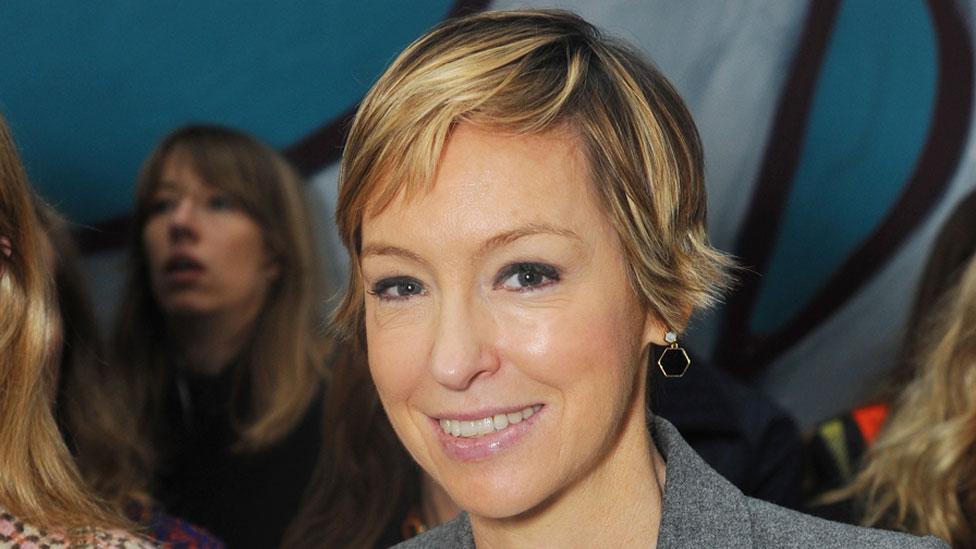Glamour magazine goes 'digital first' and cuts back print editions
- Published

The November edition of Glamour magazine, published this month
UK Glamour magazine is going "digital first", stopping its monthly editions and instead producing a "collectible, glossy" issue twice a year.
A spokeswoman told the BBC the "mobile-first, social-first" move with a focus on beauty was based on how readers are "living their life today".
Glamour will be going into consultation over jobs but "can't confirm numbers" at this stage.
The last monthly print edition will be published in November.
"We are taking our lead from our readers, who are largely women aged 20 to 54," she added.
Allow X content?
This article contains content provided by X. We ask for your permission before anything is loaded, as they may be using cookies and other technologies. You may want to read X’s cookie policy, external and privacy policy, external before accepting. To view this content choose ‘accept and continue’.
The move is for the "beauty obsessed", the magazine said, adding the content will still include "some celebrities and fashion".
The twice-yearly magazines will be out in spring and autumn, reflecting beauty and style "for the coming season".
The move will also see the editorial and commercial teams becoming "fully integrated". The BBC understands the move will result in the loss of some editorial and publishing staff.
Allow X content?
This article contains content provided by X. We ask for your permission before anything is loaded, as they may be using cookies and other technologies. You may want to read X’s cookie policy, external and privacy policy, external before accepting. To view this content choose ‘accept and continue’.
"Today's Glamour consumer moves to a different rhythm than the one who bought the magazine when it launched in 2001. It is a faster, more focused, multi-platform relationship," the magazine said, adding the "quality of ideas, vision and execution remain central".
Simon Gresham Jones, chief digital officer of Conde Nast Britain said: "We look forward to inspiring the Glamour audience in new ways."
Allow X content?
This article contains content provided by X. We ask for your permission before anything is loaded, as they may be using cookies and other technologies. You may want to read X’s cookie policy, external and privacy policy, external before accepting. To view this content choose ‘accept and continue’.
Changes to the site will begin in the coming weeks.
This move is taking place in the UK only, although the magazine is published in 17 markets including Brazil, France, Germany and the US.
Glamour is not the first magazine to change its focus to digital content - last year In Style, external magazine closed its print edition, external, while in 2014 Company, external magazine did the same, external.
Glamour UK's editor Jo Elvin was unavailable for comment.

Analysis by BBC media editor Amol Rajan
What can Glamour do online that others can't? Be better - more smart, beautiful, easy to use - perhaps. But that won't be easy.
There is no getting around the deeper structural forces that are driving this change, which is the flight of readers from print to online, and the pursuit of those readers by advertisers for whom print is an ever lower priority.
The claim that integrating editorial and commercial departments is "a further innovative move" is not up to much, because many others have been forced to do the same. And when editorial and commercial departments merge, it's generally because the money is running out and so the commercial team actually control the editorial content.

Jo Elvin is the editor of the UK's Glamour magazine
And that must be the concern for staff and indeed readers. The danger is that by moving online and focusing ever more on the traffic-generating beauty content, Glamour invests less and less in quality journalism. Of course they will deny that is either the intention or the probable danger, but it is a substantial risk.
It has felt over recent months like an era is passing in magazine culture. In the US, the editors of Vanity Fair, Time, Glamour and Elle all departed. Not so long ago Rolling Stone was sold. And in recent weeks Hugh Hefner and Si Newhouse, two giants of magazine publishing, have died.
It may seem a stretch to link those events to Glamour becoming an online beauty destination, but there is a link: the huge upheaval in journalism, driven by technology.
High quality magazine journalism still has a future online of course, but only if people pay for it. Everyone who wants to see journalism thrive will wish Glamour well, and hope it focuses on quality as it navigates this transition.

Follow us on Facebook, external, on Twitter @BBCNewsEnts, external, or on Instagram at bbcnewsents, external. If you have a story suggestion email entertainment.news@bbc.co.uk.
- Published2 November 2016
